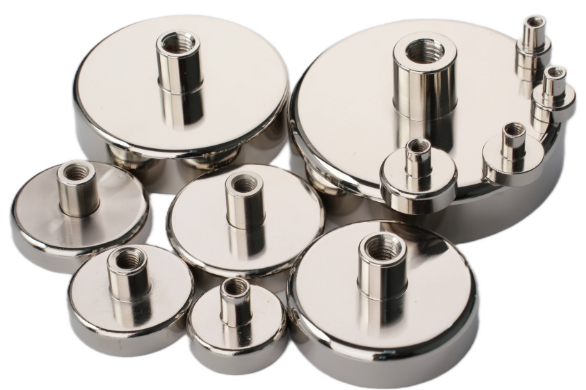Neodymium Magnets VS Ferrite Magnets
Permanent magnets are highly demanded in modern times. The strongest of all permanent magnet options are rare earth magnets. Their magnet field is very powerful, about 1.4 Tesla, while that of ferrite magnets ranges between 0.5 and 1 Tesla. That’s why rare-earth magnet styles, commonly called neodymium magnets, are said to have a permanent magnetic field. They are applied where permanence is incredibly important. Although rare-earths have high coercivity (resistance to demagnetization), Maximum Energy Product and remanence (strength of magnetic field), their Curie temperature is lower than ferrite magnets’ is. Curie temperature (Tc) is the temperature at which a magnet gets demagnetized. There are two types of a rare earth magnet. They include neodymium magnets and ferrite magnets.

What are the differences between neodymium magnets and ferrite magnets?
Neodymium
A neodymium magnet is a magnet in short. What is different from the regular magnets we see every day is that it is called the "King of Magnets" because of its excellent magnetic function.
Nd-Fe-B contains a large number of rare earth elements Nd, Fe, and B, which are hard and brittle. Because the surface is easily eroded by oxidation, the NdFeB magnet must be coated. Surface chemical passivation is one of the best treatment methods. As a rare earth permanent magnet material, neodymium magnet has a very high magnetic energy product and coercive force. At the same time, the advantages of high energy density make Nd-Fe-B permanent magnet material used in modern industry and electronic technology trivially, which makes it possible to miniaturize, lightweight and thin instruments, electroacoustic motors, magnetic separation magnetization, and other equipment.
The advantage of the neodymium magnet is its high-cost performance and excellent mechanical properties. The disadvantage of Nd-Fe-B is that its working temperature is low, its temperature characteristics are poor, and it is easy to be pulverized and eroded. It must be improved by adjusting its chemical composition and adopting surface treatment to meet the requirements of its essential use.
Nd-Fe-B magnetic material, as a new consequence of the development of rare earth permanent magnet material, is known as "Magnet King" because of its excellent magnetic function. Neodymium magnetic material is Pr-Nd metal, ferroboron and other alloys.

Ferrite
Ferrite is a ferromagnetic metal oxide.
As far as electrical properties are concerned, the resistivity of ferrite is much larger than that of metal and alloy magnetic materials, and it also has a higher dielectric function.
The magnetic function of ferrite also shows high permeability at high frequency. Therefore, ferrite has become an ordinary non-metallic magnetic material for high frequency and weak current limits. Because of the low magnetic energy reserved in the unit volume of ferrite and the low saturation magnetization (usually only 1/3-1/5 of pure iron), the application of ferrite in demanding high magnetic energy density at low frequency and high power band limits is limited. They can be used to manufacture permanent magnet starter motors, permanent magnet motors, permanent magnet concentrators, permanent magnet suspenders, magnetic thrust bearings, magnetic broadband separators, loudspeakers, microwave devices, magnetic therapy sheets, hearing aids, etc.
The saturated flux density of ferrite is low, usually only 1/3-1/5 of iron. Ferrite has a low magnetic energy reserve per unit volume, which limits its use in demanding high magnetic energy density at low frequency, high current, and high power band boundaries. It is more suitable for high frequency, low power, and weak electric field surfaces.
Nickel-zinc ferrite can be used as an antenna rod and medium frequency transformer core in radio, and manganese-zinc ferrite can be used as a line-conveying transformer core in the TV receiver. In addition, soft magnetic ferrites are also used to add sensors and filter cores in communication lines. High-frequency magnetic recording transducers have been used for many years.
What are the Strengths and Weaknesses of Neodymium Magnets and Ferrite Magnets?
--Neodymium:
Neodymium Magnet Strengths
Can lift more than any other type of magnet that is the same size Extremely resistant to demagnetization by outside magnetic fields Are the most powerful of all permanent magnets
Neodymium Magnet Weaknesses
Generally, more expensive than ferrite magnets Can rust easily, extra steps are needed to avoid corrosion Brittle and may crack under stress Can lose magnetism if exposed to temperatures above 480 degrees Fahrenheit
--Ferrite:
Ferrite Magnets Strengths
Easy to magnetize Resistant to corrosion and doesn’t require extra coatings Resistant to demagnetization by outside fields
Ferrite Magnets Weaknesses
Are extremely brittle and break easily Cannot be utilized in machines that will cause the magnet a lot of stress or flex Moderate magnetic strength makes them futile for a variety of applications Become demagnetized when exposed to temperatures above 480 degrees Fahrenheit.















